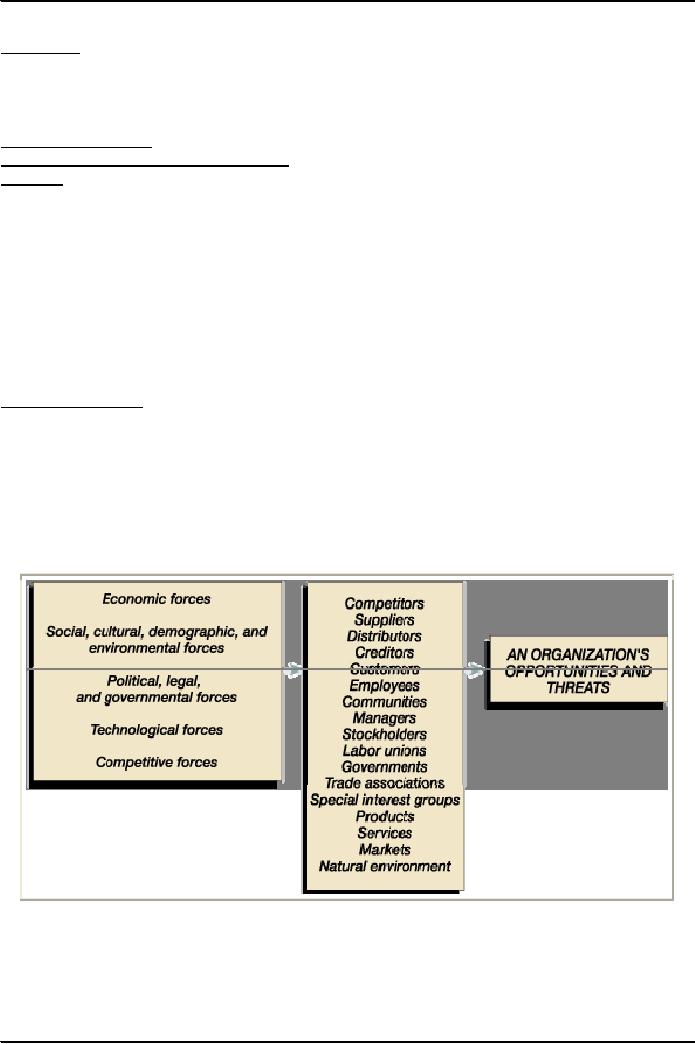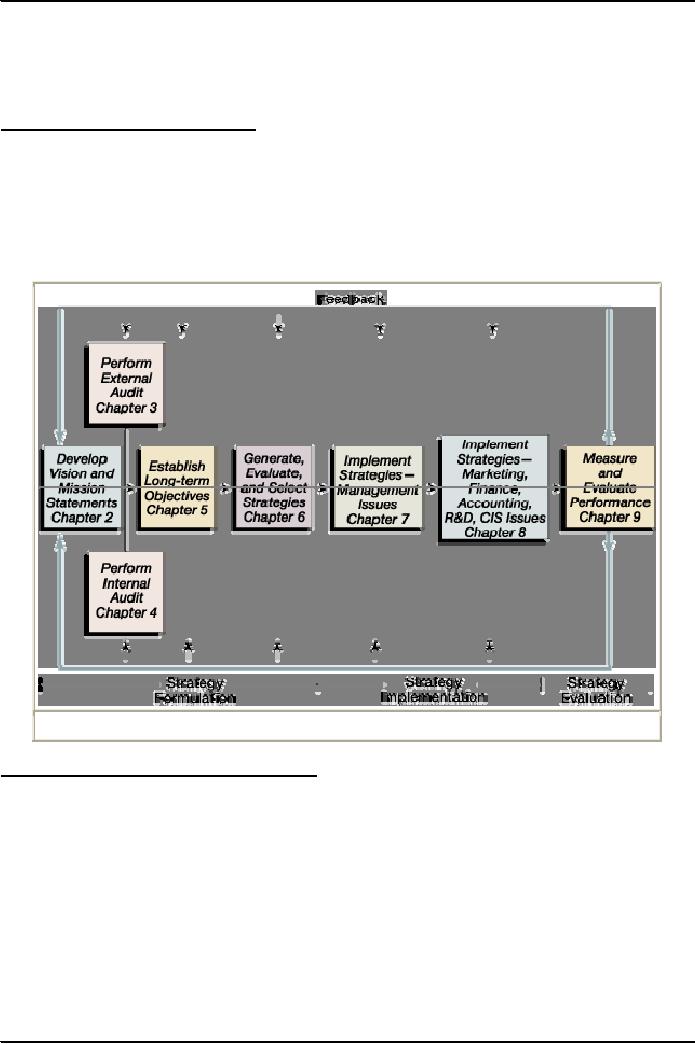 |

Strategic
Management MGT603
VU
Lesson
7
EXTERNAL
ASSESSMENT
Objectives:
This
lecture examines the tools
and concepts needed to conduct an
external strategic-management audit.
The
Nature of an External
Audit
Economic
Forces
External
Assessment:
Prediction
is very difficult, especially about
the future.
Neils
Bohr
External
Strategic Management Audit Is
also called:
1.
Environmental
scanning
2.
Industry
analysis
In
this lecture we will examine the tools
and concepts needed to conduct an
external strategic-management
audit
(sometimes called environmental
scanning or
industry
analysis). An
external
audit focuses
on identifying and
evaluating
trends and events beyond the
control of a single firm,
such as increased foreign
competition,
population
shifts to the Sunbelt, an aging
society, information technology, and the
computer revolution. An
external
audit reveals key
opportunities and threats
confronting an organization so that
managers can
formulate
strategies to take advantage of the
opportunities and avoid or
reduce the impact of threats.
This
chapter
presents a practical framework for
gathering, assimilating, and
analyzing external information.
Key
External Forces
External
forces can be
divided into five broad
categories:
Economic
forces;
Social,
cultural, demographic, and environmental
forces;
Political,
governmental, and legal
forces;
Technological
forces; and
Competitive
forces.
Relationships
among these forces and an
organization are depicted in Figure
External trends and
events
significantly
affect all products, services,
markets, and organizations in the
world.
Relationships
between Key External Forces
and an Organization are shown in the
above figure.
Changes
in external forces translate into
changes in consumer demand
for both industrial and
consumer
products
and services. External
forces affect the types of products
developed, the nature of positioning
and
market
segmentation strategies, the types of
services offered, and the
choice of businesses to acquire or
sell.
External
forces directly affect both
suppliers and distributors. Identifying
and evaluating external
opportunities
and threats enables
organizations to develop a clear mission,
to design strategies to
achieve
long-term
objectives, and to develop policies to
achieve annual
objectives.
28

Strategic
Management MGT603
VU
The
increasing complexity of business today
is evidenced by more countries'
developing the capacity
and
will
to compete aggressively in world
markets. Foreign businesses
and countries are willing to
learn, adapt,
innovate,
and invent to compete
successfully in the marketplace. There
are more competitive
new
technologies
in Europe and the Far East
today than ever before. American
businesses can no longer
beat
foreign
competitors with ease.
The
Nature of an External
Audit
The
purpose of an external audit is to develop a
finite list of opportunities
that could benefit a firm
and
threats
that should be avoided. As the term finite
suggests,
the external audit is not aimed at
developing an
exhaustive
list of every possible
factor that could influence the business;
rather, it is aimed at identifying
key
variables
that offer actionable
responses. Firms should be able to
respond either offensively or
defensively
to
the factors by formulating strategies
that take advantage of external
opportunities or that minimize the
impact
of potential threats. Figure below
illustrates how the external audit
fits into the
strategic-
management
process.
A
Comprehensive Strategic-Management
Model
The
Process of Performing an External
Audit
The
process of performing an external audit
must involve as many
managers and employees as
possible. As
emphasized
in earlier discussions, involvement in
the strategic-management process can
lead to
understanding
and commitment from organizational
members. Individuals appreciate having
the
opportunity
to contribute ideas and to
gain a better understanding of their
firm's industry, competitors, and
markets.
To
perform an external audit, a company
first must gather
competitive intelligence and information
about
social,
cultural, demographic, environmental, economic,
political, legal, governmental, and
technological
trends.
Individuals can be asked to
monitor various sources of
information such as key
magazines, trade
journals,
and newspapers. These
persons can submit periodic
scanning reports to a committee of
managers
charged
with performing the external audit. This
approach provides a continuous stream of
timely strategic
information
and involves many
individuals in the external-audit process.
The Internet provides another
source
for gathering strategic information, as
do corporate, university, and public
libraries. Suppliers,
distributors,
salespersons, customers, and competitors
represent other sources of
vital information.
29

Strategic
Management MGT603
VU
Once
information is gathered, it should be
assimilated and evaluated. A
meeting or series of meetings
of
managers
is needed to collectively identify the
most important opportunities
and threats facing the
firm.
These
key external factors should be listed on
flip charts or a blackboard. A
prioritized list of these
factors
could
be obtained by requesting all
managers to rank the factors
identified, from 1 for the
most important
opportunity/threat
to 20 for the least important
opportunity/threat. These key external
factors can vary
over
time and by industry. Relationships
with suppliers or distributors
are often a critical success
factor.
Other
variables commonly used include market
share, breadth of competing products,
world economies,
foreign
affiliates, proprietary and key
account advantages, price
competitiveness, technological
advancements,
population shifts, interest
rates, and pollution
abatement.
Freund
emphasized that these key
external factors should be:
Important
to achieving long-term and
annual objectives,
Measurable,
Applicable
to all competing firms, and
Hierarchical
in the sense that some will
pertain to the overall company and
others will be more
narrowly
focused on functional or divisional
areas.
A
final list of the most
important key external factors should be
communicated and distributed widely
in
the
organization. Both opportunities and
threats can be key external
factors.
Economic
Forces
Economic
factors have a direct impact on the
potential attractiveness of various
strategies. For example,
as
interest
rates rise, then funds
needed for capital expansion
become more costly or
unavailable. Also, as
interest
rates rise, discretionary
income declines, and the
demand for discretionary goods
falls. As stock
prices
increase, the desirability of equity as a source of
capital for market development
increases. Also, as
the
market rises, consumer and
business wealth expands. A summary of
economic variables that
often
represent
opportunities and threats
for organizations is provided in
Table given below.
Key
Economic Variables to Be
Monitored
�
Shift
to a service economy in
the
United States
�
Import/export
factors
�
Availability
of credit
�
Demand
shifts for different
categories of
�
Level
of disposable income
goods
and services
�
�
Propensity
of people to spend
Income
differences by region
and
�
consumer
groups
Interest
rates
�
�
Price
fluctuations
Inflation
rates
�
�
Money
market rates
Exportation
of labor and capital
from
�
the
United States
Federal
government budget
�
Monetary
policies
deficits
�
�
Gross
domestic product
trend
Fiscal
policies
�
�
Consumption
patterns
Tax
rates
�
�
European
Economic Community (ECC)
Unemployment
trends
�
policies
Worker
productivity levels
�
�
Organization
of Petroleum Exporting
Value
of the dollar in world
Countries
(OPEC) policies
markets
�
�
Coalitions
of
Lesser
Developed
Stock
market trends
Countries
(LDC) policies
�
Foreign
countries' economic
conditions
30
Table of Contents:
- NATURE OF STRATEGIC MANAGEMENT:Interpretation, Strategy evaluation
- KEY TERMS IN STRATEGIC MANAGEMENT:Adapting to change, Mission Statements
- INTERNAL FACTORS & LONG TERM GOALS:Strategies, Annual Objectives
- BENEFITS OF STRATEGIC MANAGEMENT:Non- financial Benefits, Nature of global competition
- COMPREHENSIVE STRATEGIC MODEL:Mission statement, Narrow Mission:
- CHARACTERISTICS OF A MISSION STATEMENT:A Declaration of Attitude
- EXTERNAL ASSESSMENT:The Nature of an External Audit, Economic Forces
- KEY EXTERNAL FACTORS:Economic Forces, Trends for the 2000’s USA
- EXTERNAL ASSESSMENT (KEY EXTERNAL FACTORS):Political, Governmental, and Legal Forces
- TECHNOLOGICAL FORCES:Technology-based issues
- INDUSTRY ANALYSIS:Global challenge, The Competitive Profile Matrix (CPM)
- IFE MATRIX:The Internal Factor Evaluation (IFE) Matrix, Internal Audit
- FUNCTIONS OF MANAGEMENT:Planning, Organizing, Motivating, Staffing
- FUNCTIONS OF MANAGEMENT:Customer Analysis, Product and Service Planning, Pricing
- INTERNAL ASSESSMENT (FINANCE/ACCOUNTING):Basic Types of Financial Ratios
- ANALYTICAL TOOLS:Research and Development, The functional support role
- THE INTERNAL FACTOR EVALUATION (IFE) MATRIX:Explanation
- TYPES OF STRATEGIES:The Nature of Long-Term Objectives, Integration Strategies
- TYPES OF STRATEGIES:Horizontal Integration, Michael Porter’s Generic Strategies
- TYPES OF STRATEGIES:Intensive Strategies, Market Development, Product Development
- TYPES OF STRATEGIES:Diversification Strategies, Conglomerate Diversification
- TYPES OF STRATEGIES:Guidelines for Divestiture, Guidelines for Liquidation
- STRATEGY-FORMULATION FRAMEWORK:A Comprehensive Strategy-Formulation Framework
- THREATS-OPPORTUNITIES-WEAKNESSES-STRENGTHS (TOWS) MATRIX:WT Strategies
- THE STRATEGIC POSITION AND ACTION EVALUATION (SPACE) MATRIX
- THE STRATEGIC POSITION AND ACTION EVALUATION (SPACE) MATRIX
- BOSTON CONSULTING GROUP (BCG) MATRIX:Cash cows, Question marks
- BOSTON CONSULTING GROUP (BCG) MATRIX:Steps for the development of IE matrix
- GRAND STRATEGY MATRIX:RAPID MARKET GROWTH, SLOW MARKET GROWTH
- GRAND STRATEGY MATRIX:Preparation of matrix, Key External Factors
- THE NATURE OF STRATEGY IMPLEMENTATION:Management Perspectives, The SMART criteria
- RESOURCE ALLOCATION
- ORGANIZATIONAL STRUCTURE:Divisional Structure, The Matrix Structure
- RESTRUCTURING:Characteristics, Results, Reengineering
- PRODUCTION/OPERATIONS CONCERNS WHEN IMPLEMENTING STRATEGIES:Philosophy
- MARKET SEGMENTATION:Demographic Segmentation, Behavioralistic Segmentation
- MARKET SEGMENTATION:Product Decisions, Distribution (Place) Decisions, Product Positioning
- FINANCE/ACCOUNTING ISSUES:DEBIT, USES OF PRO FORMA STATEMENTS
- RESEARCH AND DEVELOPMENT ISSUES
- STRATEGY REVIEW, EVALUATION AND CONTROL:Evaluation, The threat of new entrants
- PORTER SUPPLY CHAIN MODEL:The activities of the Value Chain, Support activities
- STRATEGY EVALUATION:Consistency, The process of evaluating Strategies
- REVIEWING BASES OF STRATEGY:Measuring Organizational Performance
- MEASURING ORGANIZATIONAL PERFORMANCE
- CHARACTERISTICS OF AN EFFECTIVE EVALUATION SYSTEM:Contingency Planning